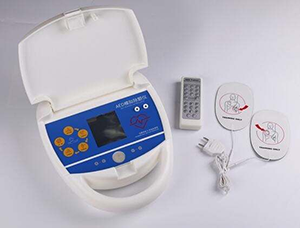

Article tag: Simulated defibrillator| medical teaching model|
In summary, analog defibrillators, as a bridge between theory and practice, play a vital role in upgrading the defibrillation skills of healthcare professionals. It can not only help medical personnel master the basic operation and skill points of defibrillation, but also promote the communication and c...
In the field of medical emergency, defibrillation is a vital life-saving technique that requires medical personnel to quickly and accurately judge and perform defibrillation operations in emergency situations to restore the normal rhythm of the patient's heart. However, the process from theoretical learning to practical operation to seamless application in real rescue scenarios is not an overnight process. Analog defibrillator, as a bridge between theory and practice, plays an irreplaceable role.
First, a highly simulated operating interface and feedback mechanism enable healthcare professionals to practice defibrillation skills repeatedly in a safe, risk-free environment. This exercise not only covers the basic operation of the defibrillator, such as the placement of the electrode plate, the choice of energy, the timing of electric shock, etc., but also simulates the physiological response of patients under different conditions, so that medical staff can understand and master the whole process of defibrillation more comprehensively.

Secondly, it has the function of teaching evaluation. During the exercise process, the system can record and analyze the operation data of medical staff in real time, such as reaction time, operation accuracy, etc., and give corresponding feedback and suggestions. This immediate feedback mechanism helps the medical staff to identify and correct their own mistakes in time, so that they can gradually improve their defibrillation skills through continuous practice.
More importantly, it provides a training platform for medical staff to work together as a team. In a real rescue scenario, defibrillation often requires the close cooperation of multiple medical personnel. And this kind of team cooperation scene can be simulated, so that medical staff can learn how to effectively communicate with colleagues and coordinate the division of labor in the practice, so as to quickly form a tacit understanding in the actual rescue and improve the rescue efficiency.
Finally, by simulating the defibrillator repeatedly and evaluating feedback, healthcare professionals can gradually build confidence and proficiency in the defibrillator skill. When faced with a real emergency, they can be more leisurely to meet the challenge, ensure the accuracy and timeliness of defibrillation operations, and gain valuable life time for patients.
In summary, analog defibrillators, as a bridge between theory and practice, play a vital role in upgrading the defibrillation skills of healthcare professionals. It can not only help medical personnel master the basic operation and skill points of defibrillation, but also promote the communication and cooperation between medical personnel through teaching evaluation and team cooperation drills, and improve the overall rescue level.